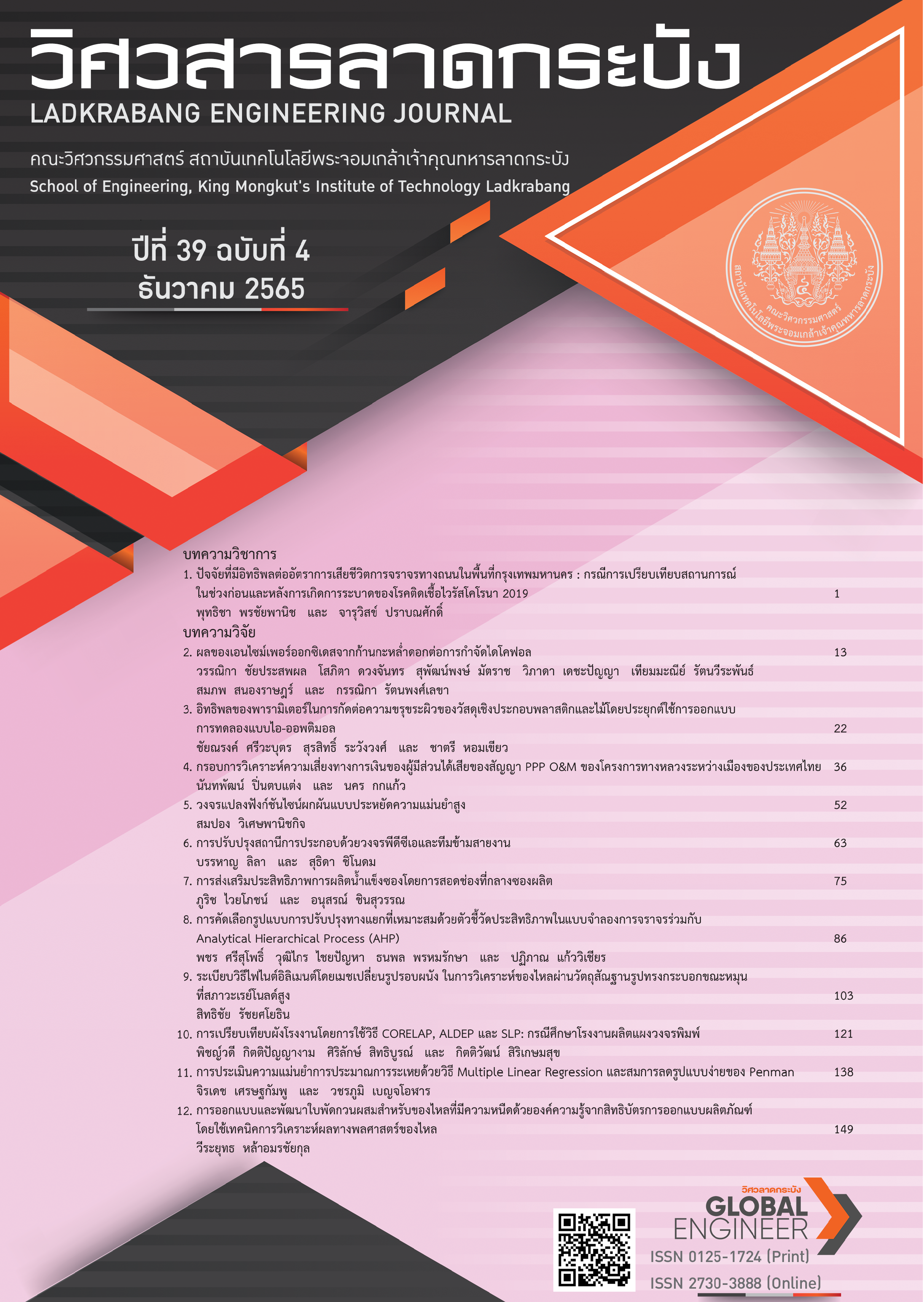Designing and Developing Mixed Stirring Rotors for Viscous Fluids with Knowledge from Product Design Patents using Computational Fluid Dynamics Technique
Abstract
The purpose of this study is to show a turbulent flow field pattern inside a mixing stirring tank, with the simulated fluid being a viscosity is 1.8 Pa. s at 98 degrees Celsius. The study process began with the use of a 45-degree angled mixing rotor (pitch blade) developed from product design patent no. 62881. After that, the production power of the mixing machines was optimized. The redesigned mixing rotor has a diameter of 334 millimeters, and the calculated mixing tank is 1,002 millimeters in diameter and has a height of 1,002 millimeters. The mango mixing machine was driven by a 1 horsepower, single-phase electric motor and used a transmission belt. Numerical simulation results and comparisons show the effect of design on hand-computed variables. The variables in this study were obtained by calculation and computational fluid dynamics techniques. And can be applied to the design and development of various stirrers in the future.
References
Y. G. Chun, J. W. Jia, P. G. Xue and F. F. Lian, “CFD simulation and PIV measurement of the flow field generated by modified pitched blade turbine impellers,” Chemical Engineering Research and Design, vol. 92, no. 6, pp. 1027–1036, 2014, doi: 10.1016/j.cherd.2013.08.024.
F. Delvigne, J. Destain and P. Thonart, “Structureed Mixing Model for Stirred Bioreactors: An Extension to the Stochastic Approach,” Chemical Engineering Journal, vol. 113, no.1, pp. 1–12, 2005, doi: 10.1016/j.cej.2005.06.007.
O. Shengchao, W. Rijie, Y. Xiaoxia and Y. Yuefei, “CFD Prediction of mean Flow Field and Impeller Capacity for Pitched Blade Turbine,” Thansections of Tianjin University, vol.21, no.3, pp. 250–258, 2015, doi: 10.1007/s12209-015-2408-x.
T. Baramee, N. Apinan, E. Chakron, B. Ekkarat and W. Santi, “Effect of Rushton turbine shapes on mixing performance by computational fluid dynamics,” in Proc. 28th Thai Institute of Chemical Engineering and Applied Chemistry Conference (TIChE 2019), Chonburi, Thailand, Nov. 8–9, 2019, pp.146-152.
L. Werayoot, “Mechanical Part of Water Aerator,” Thailand Patent 62881. May. 9, 2018.
L. Werayoot, “Design and CFD Simulation of Agitating Blade in Tank for Mixing Fluids,” Ladkrabang Engineering Journal, vol. 37, no.1, pp. 13–20, 2020.
L. Werayoot, B. Pinich and K. Nuttapong, “Simulation of Fluid Mixing in Food Industry using Computational Fluid Dynamics,” in The, 4th National Food Engineering Conference, Pathumthani, Thailand, Apr. 3, 2018, pp.10–15.
S. Suntorn, P. Santri and K. Suntri, “Development of a Mango Machine that uses Heat from Liquefied Petroleum Gas (LPG) for Community Use,” in The, 33rd Conference of Mechanical Engineering Network, Udon Thani, Thailand, Jul. 2–5, 2019, pp. 243.
D. Kamonrat, P. Rattapon, N. M. Wisarut, and S. Suntorn, “Development of black coconut sweet pudding agitators for community use,” in The, 32nd Conference of Mechanical Engineering Network of Thailand, Mukdahan, Thailand, Jul. 3–6, 2018, p.1.
J. Ronnarit, and C. Athika, “The Development of a Curry Puff Filling Mixing Machine Using Heat from Liquefied Petroleum Gas (LPG) for Community Use,” Udon Thani Rajabhat University Journal of Sciences and Technology, vol. 8, no.1, pp. 75-87, 2021.
W. Worawit, “Tamarind Mixing Machine” Rajamangala University of Technology Phra Nakhon, Bangkok, Thailand, Final Rep., 2007. Accessed: Sep. 16, 2022 [Online]. Available:https://repository.rmutp.ac.th/bitstream/handle/123456789/642/Tamarind%20Mixing%20Machine.pdf?sequence=1&isAllowed=y.
L. Werayoot, “Design and flow field analysis of agitation turbine using numerical simulation,” UBU Engineering Journal, vol. 14, no.1, pp. 105–114, 2021.
S. Pongsaran and K. Yostana, “Computational Fluid Dynamics Modeling of Anaerobic Continuously Stirred Tank Reactor,” in Proc. 28th Conference of Mechanical Engineering Network, Khon Kaen, Thailand, Oct. 15–17, 2014, pp.857–864.
C. Amonwan, “Mixing Characteristics Improvement in Equalization Tank for Capacity Enhancement of Wastewater,” M.S. thesis, Dept. Chemical and Environment Eng., Burapha Univ., Chonburi, Thailand, 2016.
S. Patigorn, “Study of Flocculation Mixing Efficiency by using Grids Combined with A Dual Rushton Turbine Impeller,” M.S. thesis, Dept. Environment Eng., Suranaree University of Technology., Nakhon Ratchasima, Thailand, 2002.
T. Charn and U. Variddhi, “Shaft Design,” in Machine Design, 1st ed. Bangkok, Thailand: Se-Education Public Company Limited, Thailand, 2013, ch. 9, sec. 9.4-9.7, pp. 267–283.
B. Suvendu, “Yield Stress and Time-dependent Rheological Properties of Mango Pulp,” Journal of Food Science, vol. 64, no.6, pp. 1029–1033, 1999, doi: 10.1111/j.1365-2621. 1999.tb12275. x.
G. Anuradha, S. R. Hosahalli and A. Jasim, “Effect of Soluble Solids Concentration and Temperature on Thermo-Physical and Rheological Properties of Mango Puree,” International Journal of Food Properties, vol. 14, no. 5, pp. 1018–1036, 2011, doi: 10.1080/10942910903580876.
S. Phaokuntha, P.B. Poonlarp, and I. Pongsirikul, “Rheological Properties of Mango Puree and Process Development of Mango Sheet,” International Symposium on Tropical and Subtropical Fruits, vol. 1024, pp. 373–379, 2014, doi: 10.17660/ActaHortic.2014.1024.51.
M. Dular, T. Bajcar, L. Slemenik-Perse, M. Zumer and B. Sirok, “Numerical Simulation and Experimental Study of Non-Newtonian Mixing Flow with a Free Surface,” Brazilian Journal of Chemical Engineering, vol.23, no. 4, pp. 473–486, 2006, doi: 10.1590/S0104-66322006000400005.
Downloads
Published
How to Cite
Issue
Section
License
Copyright (c) 2022 Faculty of Engineering, King Mongkut’s Institute of Technology Ladkrabang

This work is licensed under a Creative Commons Attribution-NonCommercial-NoDerivatives 4.0 International License.
The published articles are copyrighted by the School of Engineering, King Mongkut's Institute of Technology Ladkrabang.
The statements contained in each article in this academic journal are the personal opinions of each author and are not related to King Mongkut's Institute of Technology Ladkrabang and other faculty members in the institute.
Responsibility for all elements of each article belongs to each author; If there are any mistakes, each author is solely responsible for his own articles.






